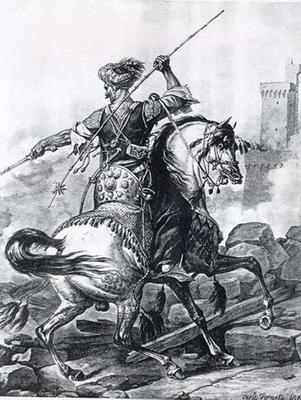David IV also known as David the BuilderSource 1:
WikipediaProblems began to crop up for David now, his population, having been at war for the better part of twenty years needed to be allowed to become productive again. As well, his nobles were still making problems for him, along with the city of Tbilisi which still could not be liberated from Arab grasp. Again David was forced to solve these problems before he could continue the reclamation of his nation and people. For this purpose, David IV radically reformed his military. He resettled a Kipchak tribe of 40,000 families from the Northern Caucasus in Georgia in 1118-1120. Every family was obliged to provide one soldier with a horse and weapons. This 40,000 strong Kipchak-army was entirely dependent on the King. Kipchaks were settled in different regions of Georgia. Some were settled in Inner Kartli province, others were given lands along the border. They were quickly assimilated into Georgians.
Source 2:
Academician R. Metreveli, Tbilisi State University
To ensure quick movement King David the Builder increased the number of troops and cavalry detachments; he changed the strategy and tactics of warfare. The King especially favored the stratagem of luring the enemy into an ambush and effecting a surprise attack. Part of the Georgian army still depended upon big feudal lords, their will and wishes, and their relations with the king. At the same time incessant wars kept the most productive part of the population away from home and farming. The country's power depended not only on the organization of the army, but on economic regeneration as well. In view of this the need arose for creating an army of non-local population. The Crown settled some 40,000 families of the Polovtsy on Georgian territory. Presently they became integrated into the local feudal relations and each family gave one warrior, creating an army of 40,000 men. In this way King David sought to maximally limit the political rights of the feudal lords and to strengthen the royal authority. The settlement of the Polovtsy in Georgia in 1118-1120 and the creation of a standing army recruited from them made the king practically independent of Georgian feudal lords and strengthened the country as a whole.
But who have been those
Polovtsy ? Those
Kipchaks ? They fought endless battles against the Russians in Southrussia. A very good source on the history of those tribes I found here at
http://www.redkaganate.org/ by
Dmitriy V. Ryaboy. There also can be found a brilliant
Timeline of the Russo-Polovetz Wars by
Norman J. Finkelshteyn.
What says Wikipedia:
The Cumans, also known as Polovtsy (Slavic for yellowish) were a nomadic West Turkic tribe living on the north of the Black Sea along the Volga. They are identified with the Western branch of the Kipchaks. They invaded Southern Ukraine, Moldova, Wallachia and part of Transylvania in the 11th century and from here they continued their plundering of the Byzantine Empire, Hungary and Kievan Rus'.
Full Article here















